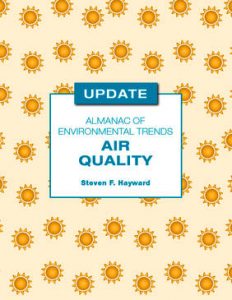The reduction in air pollution continues to be the most successful domain of pollution reduction since the first Earth Day in 1970. Since the first edition of this Almanac two years ago, reductions in air pollution have been astonishing. The EPA recently updated its inventory of ambient air pollution levels monitored through 2010, and its model estimates of emissions through 2012.
The new EPA data show some of the largest drops in ambient air pollution ever in 2009 and 2010, though some of this decline may have been related to the reduced economic activity of the long recession, while some of the reductionsespecially in sulfur dioxideare explained by the unforeseen rapid replacement of coal-fired electricity by natural gas.
Nothing contained in this blog is to be construed as necessarily reflecting the views of the Pacific Research Institute or as an attempt to thwart or aid the passage of any legislation.
2013 Supplement to the 2011 Environmental Almanac
Steven Hayward
The reduction in air pollution continues to be the most successful domain of pollution reduction since the first Earth Day in 1970. Since the first edition of this Almanac two years ago, reductions in air pollution have been astonishing. The EPA recently updated its inventory of ambient air pollution levels monitored through 2010, and its model estimates of emissions through 2012.
The new EPA data show some of the largest drops in ambient air pollution ever in 2009 and 2010, though some of this decline may have been related to the reduced economic activity of the long recession, while some of the reductionsespecially in sulfur dioxideare explained by the unforeseen rapid replacement of coal-fired electricity by natural gas.

DOWNLOAD the PDF
Nothing contained in this blog is to be construed as necessarily reflecting the views of the Pacific Research Institute or as an attempt to thwart or aid the passage of any legislation.
Subscribe to our newsletter: